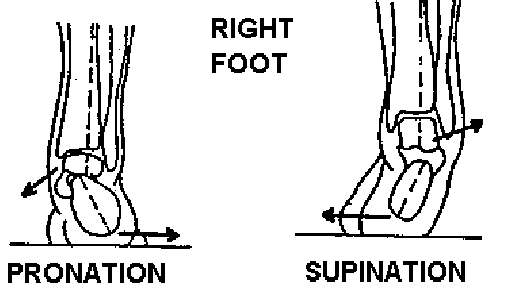Subtalar joint motion (closed chain)
The figure illustrates closed chain (talar and calcaneal) movement in the right subtalar joint. In a closed chain activity like walking, subtalar motion links foot motions with motions at other lower extremity joints.
| | 
|
|---|
| | PRONATIONSUPINATION
CALCANEUSevertsinverts
TALUS*plantar flexes
adducts dorsiflexes
abducts
TIBIArotates internallyrotates externally
KNEEflexes extends
| | | | | | | | | | | | | |
|---|
*We typically use terms like adduction or plantar flexion to describe motion at a motion, not motion of a bone like the talus. In this usage, "adduction" and "plantar flexion" describe movement of the talus' anterior portion. In subtalar pronation, the talus' anterior portion moves inferiorly (talar plantar flexion) and medially (talar adduction).
Some students are initially concerned when they read that the talus plantar flexes and adducts during closed chain pronation. Because they know that open chain pronation has components of dorsiflexion and abduction, they wonder if open and closed chains motions occur in opposite directions.
However, open and closed chain subtalar motions, like pronation, are exactly alike at the subtalar joint surface.
- In a closed chain, the talus is mobile while the foot's distal part (the "forefoot") is fixed by its contact with the ground. The mobile talus plantar flexes and adducts (its anterior part tips inferiorly and medially).
- During open chain pronation, the talus is fixed, so the mobile forefoot dorsiflexes and abducts.
- These motions are identical. They differs only in whether the forefoot moves on a stable talus, or the talus moves on the stable forefoot.
Comparison of OPEN AND CLOSED CHAIN SUBTALAR MOVEMENT:
| PRONATION | SUPINATION
| OPEN CHAIN
(TALUS IS STABLE) | CLOSED CHAIN
(TALUS IS MOBILE) | OPEN CHAIN
(TALUS IS STABLE) | CLOSED CHAIN
(TALUS IS MOBILE)
| | CALCANEUS | EVERTSEVERTSINVERTSINVERTS
| TALUS | (stable)ADDUCTS
PLANTAR FLEXES(stable)ABDUCTS
DORSIFLEXES
| FOREFOOT | ABDUCTS
DORSIFLEXES(stable) ADDUCTS
PLANTAR FLEXES(stable)
| | | |
|---|
| | | |
|---|
| | | |
|---|
|
|
Closed chain subtalar pronation occurs during the loading response phase of the walking cycle.
- In a closed chain, tibial internal rotation produces talar "internal rotation," typically called talar adduction.
- The talus also plantar flexes and the calcaneus everts
- Subtalar pronation influences the alignment of the two axes of the midtarsal joint, making them more parallel.
- Parallel alignment of the midtarsal axes permits the foot to be flexible and to adapt to different surfaces.
- Pronation produces a "functional shortening" of the lower limb, which allows for shock absorption during loading response.
Closed chain subtalar supination occurs during the midstance and terminal stance phases of the walking cycle.
- In a closed chain, tibial external rotation produces talar "external rotation," typically called talar abduction.
- The talus also dorsiflexes and the calcaneus inverts.
- Subtalar supination influences the alignment of the two axes of the midtarsal joint, causing them to become non-parallel.
- Non-parallel alignment of the midtarsal axes permits the foot to become rigid to support the body's weight and to provide rigid lever for propulsion.
The subtalar joint is a source of movement that can compensate for limitations in other structures. These compensations can lead to problems, and so may require orthotic management.

